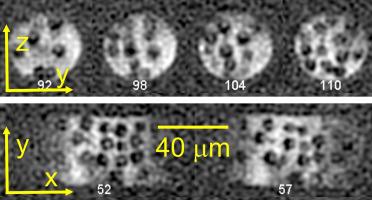Progress in Nuclear Magnetic Resonance Spectroscopy ( IF 6.1 ) Pub Date : 2023-10-17 , DOI: 10.1016/j.pnmrs.2023.10.001 Robert Tycko

|
Extension of magnetic resonance imaging (MRI) techniques to the single micron scale has been the goal of research in multiple laboratories over several decades. It has proven difficult to achieve isotropic spatial resolution better than 3.0 μm in inductively-detected MRI near 300 K, even with well-behaved test samples, microcoils, and optimized MRI pulse sequences. This article examines the factors that limit spatial resolution in MRI, especially the inherently low signal-to-noise ratio of nuclear magnetic resonance (NMR), and explains how these limiting factors can be overcome in principle, by acquiring MRI data at low temperatures and using dynamic nuclear polarization (DNP) to enhance signal amplitudes. Recent efforts directed at micron-scale MRI enabled by low-temperature DNP, culminating in images with 1.7 μm isotropic resolution obtained at 5 K, are reviewed. The article concludes with a discussion of areas in which further developments are likely to lead to further improvements in resolution, eventually to 1.0 μm or better.
中文翻译:

基于低温和动态核极化的微米级磁共振成像
将磁共振成像(MRI)技术扩展到单微米尺度一直是多个实验室几十年来研究的目标。事实证明,即使使用性能良好的测试样本、微线圈和优化的 MRI 脉冲序列,在 300 K 附近的感应检测 MRI 中也很难实现优于 3.0 μm 的各向同性空间分辨率。本文研究了限制 MRI 空间分辨率的因素,特别是核磁共振 (NMR) 固有的低信噪比,并解释了如何通过在低温和低温下采集 MRI 数据原则上克服这些限制因素。使用动态核极化 (DNP) 来增强信号幅度。回顾了最近通过低温 DNP 实现微米级 MRI 的努力,最终在 5 K 下获得了 1.7 μm 各向同性分辨率的图像。本文最后讨论了进一步发展可能导致分辨率进一步提高的领域,最终达到 1.0 μm 或更好。



























 京公网安备 11010802027423号
京公网安备 11010802027423号